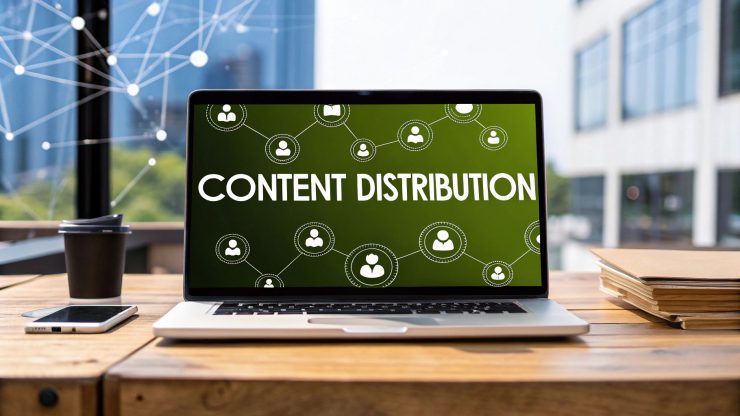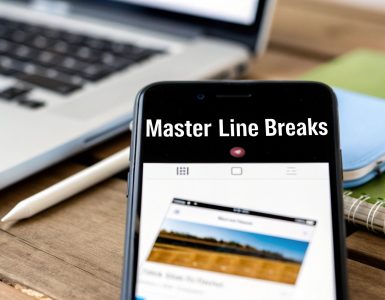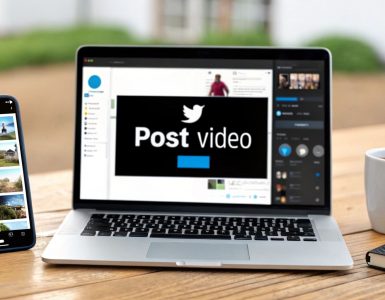Creating exceptional content is only half the battle. Without a robust plan to deliver it to the right audience, even the most brilliant blog post, insightful video, or compelling report will go unnoticed. The real challenge lies in navigating the noisy digital landscape to ensure your message not only reaches but also resonates with the people who need to see it. This isn't just about posting and hoping for the best; it's about strategic execution.
Many marketers face a frustrating delay between publishing content and seeing it appear in search results. One powerful way to ensure your content is discovered and seen quickly after publication, directly addressing these delays, is through methods explored in a guide to faster SEO with instant indexing. Visibility is the first, crucial step.
This guide moves beyond generic advice to detail 10 potent content distribution strategies that top marketers use to amplify their reach, drive meaningful engagement, and achieve measurable results. We will break down each strategy into actionable steps, pros, cons, and real-world examples, providing a comprehensive playbook for getting your content in front of the people who matter most.
Instead of just creating content, you'll learn how to activate it. We'll cover everything from leveraging your owned channels and mastering social platforms to building powerful influencer partnerships and syndicating your work for maximum exposure. Prepare to transform your content from a silent asset into a powerful engine for growth.
1. Owned Media Distribution
Owned media distribution is the foundational pillar of a sustainable content strategy. It involves publishing content on platforms that your brand has complete control over, such as your company website, blog, email newsletters, and proprietary mobile apps. This approach gives you ultimate authority over your messaging, design, user experience, and, most importantly, your direct relationship with your audience.

Unlike paid or earned media, you are not renting space or relying on third-party algorithms. Instead, you are building a valuable, long-term asset that appreciates over time, a concept popularized by marketing pioneers like Joe Pulizzi and Brian Clark. Think of HubSpot's blog, which has become a go-to resource for millions, or Glossier's 'Into the Gloss' blog, which built a massive community before ever selling a product. These platforms exemplify owned media's power to create a direct line to consumers.
Why It's a Top Strategy
Owned media is the home base for all your marketing efforts. It allows you to capture invaluable first-party data, understand audience behavior through analytics, and nurture leads without paying for every click or impression. This control makes it one of the most cost-effective and powerful content distribution strategies for building brand equity and fostering customer loyalty.
Actionable Implementation Tips
- Prioritize SEO: Treat your blog or website as a long-term investment. Optimize every piece of content with relevant keywords to attract consistent organic traffic. Focus on creating cornerstone or pillar pages for your most important topics to establish authority.
- Build Your Email List: Embed email capture forms, pop-ups, and content upgrade offers across your site. An email list is a direct distribution channel you own, immune to algorithm changes on social platforms.
- Create Evergreen Content: Develop resources, guides, and tutorials that remain relevant and valuable long after they are published. This type of content continuously draws traffic and builds your reputation as an industry expert.
- Maintain Consistency: Establish and stick to a regular publishing schedule. Whether it's a weekly blog post or a bi-weekly newsletter, consistency trains your audience to anticipate and engage with your content.
2. Social Media Platform Distribution
Social media platform distribution leverages the vast user bases of networks like Facebook, Instagram, LinkedIn, and TikTok to share content, foster engagement, and drive brand awareness. This strategy involves more than just cross-posting; it requires tailoring your core message to the unique culture, format, and user expectations of each individual platform. It is a powerful method for meeting your audience where they already spend their time.

This approach was popularized by digital marketing pioneers like Gary Vaynerchuk, who famously documented his content model of creating pillar content and then distributing it in dozens of native formats across social channels. Brands like Wendy's have mastered this with their witty Twitter presence, while Glossier built a billion-dollar brand by cultivating a dedicated community on Instagram. These examples showcase social media's ability to create immediate, interactive touchpoints with consumers.
Why It's a Top Strategy
Social media provides an unparalleled opportunity for real-time feedback, community building, and viral potential. Unlike owned media, which requires audiences to come to you, social distribution actively pushes your content into their daily feeds. This makes it one of the most effective content distribution strategies for amplifying your reach, generating brand conversations, and driving traffic back to your owned media properties.
Actionable Implementation Tips
- Tailor Content Natively: Adapt your content for each platform. A professional case study on LinkedIn should become an engaging visual carousel on Instagram, a short-form video on TikTok, and a discussion thread on Twitter.
- Engage Authentically: Don’t just post and ghost. Respond to comments, answer questions, and participate in conversations. Authentic engagement builds community and loyalty, signaling to algorithms that your content is valuable.
- Leverage Platform-Specific Features: Use features like Instagram Stories, LinkedIn Polls, and TikTok Duets. These formats are prioritized by platform algorithms and encourage high levels of user interaction.
- Analyze Performance Data: Consistently monitor your analytics to see what works. Track metrics like engagement rate, reach, and click-throughs to identify top-performing content formats and optimal posting times for your specific audience.
3. Email Marketing Distribution
Email marketing distribution is one of the most direct and personal content distribution strategies, involving sending targeted content straight to subscribers' inboxes. This channel encompasses newsletters, promotional campaigns, and automated sequences, giving you a direct line of communication to an audience that has explicitly opted in to hear from you. It provides unparalleled access with historically high engagement rates and a strong return on investment.

Unlike social media, where algorithms dictate reach, email puts you in control of the delivery. This strategy has been perfected by figures like Ann Handley of MarketingProfs and Joanna Wiebe of Copyhackers, who demonstrate its power to build relationships and drive action. Modern successes like Morning Brew's daily newsletter, which grew to over 4 million subscribers, or TheSkimm's news digest, which built a massive community of millennial women, showcase email's enduring relevance and effectiveness in building a loyal audience.
Why It's a Top Strategy
Email marketing is a cornerstone strategy because it nurtures a direct, one-to-one relationship with your audience on a platform they check daily. It allows for deep personalization and segmentation, ensuring that your content is highly relevant to each recipient. This precision maximizes engagement and drives conversions, making it an incredibly effective tool for moving leads through the sales funnel. For deep insights into leveraging this channel, consider developing a winning ecommerce email marketing strategy.
Actionable Implementation Tips
- Segment Your Lists: Group subscribers based on demographics, purchase history, or on-site behavior. Sending tailored content to specific segments dramatically increases relevance and engagement.
- A/B Test Everything: Continuously test subject lines, send times, calls-to-action, and content formats to optimize performance. Small tweaks can lead to significant improvements in open and click-through rates. Discover more with these tips on writing catchy email subject lines.
- Automate Nurture Sequences: Set up automated welcome series for new subscribers and nurture sequences for leads. This ensures consistent communication and guides users along their journey without manual effort.
- Monitor Deliverability and Health: Regularly clean your email list to remove inactive subscribers and monitor your sender reputation. Strong deliverability ensures your messages actually land in the inbox, not the spam folder.
4. Influencer Partnership Distribution
Influencer partnership distribution involves collaborating with individuals who have established credibility and large, engaged followings in specific niches. This strategy leverages the trust and authentic relationship influencers have built with their audiences, allowing your content to be shared in a voice that resonates deeply with a target demographic. It’s a powerful method to tap into pre-existing communities and gain instant social proof.

This approach was popularized by early digital creators like Chiara Ferragni (The Blonde Salad) and has been masterfully executed by brands like Gymshark, which built its empire through fitness influencer collaborations. Instead of a direct brand-to-consumer ad, the content is presented as a trusted recommendation, significantly boosting its credibility. Fenty Beauty's launch campaign, which utilized a diverse range of beauty influencers, is another prime example of how this strategy can drive massive awareness and cultural impact.
Why It's a Top Strategy
Influencer collaborations act as a powerful shortcut to building trust and reaching highly targeted audiences at scale. When a respected creator shares your content, their endorsement transfers credibility to your brand. This form of earned media is one of the most effective content distribution strategies because it combines the reach of paid advertising with the authenticity of word-of-mouth marketing, often leading to higher engagement and conversion rates than traditional ads.
Actionable Implementation Tips
- Prioritize Alignment Over Reach: Select influencers whose values, audience demographics, and content style genuinely align with your brand. A micro-influencer with a highly engaged, niche audience can be far more valuable than a macro-influencer with misaligned followers.
- Focus on Engagement Metrics: Look beyond follower counts. Analyze an influencer's average likes, comments, shares, and view-through rates to gauge the true health and responsiveness of their community.
- Grant Creative Freedom: Provide clear brand guidelines but allow the influencer creative control to ensure the content feels native to their channel and authentic to their audience. Forced, overly scripted content can easily backfire.
- Track Performance with Unique Codes: Use unique affiliate links, UTM parameters, or custom discount codes for each influencer. This allows you to accurately measure ROI and identify your most effective partners. For agencies managing multiple campaigns, exploring marketing automation for creator management can streamline this tracking and outreach process.
5. SEO-Optimized Content Distribution
SEO-optimized content distribution is a strategy centered on creating and placing content to achieve high rankings in search engine results pages (SERPs). This method goes beyond simple publishing; it involves meticulous keyword research, on-page optimization, and strategic content placement to capture valuable organic search traffic. It transforms your content from a standalone piece into a long-term lead-generation asset that works for you 24/7.
Unlike paid ads that stop delivering traffic the moment you stop paying, this approach builds sustainable visibility. Think of Backlinko's comprehensive guides that rank for highly competitive SEO keywords, or Canva's design tutorials that answer millions of user queries. These companies, championed by experts like Brian Dean and Neil Patel, have built empires by systematically creating content that directly answers what their target audience is searching for, establishing immense authority and driving consistent traffic.
Why It's a Top Strategy
Search engines are the primary way users find information, making SEO an indispensable channel. By aligning your content with search intent, you attract a highly motivated audience actively looking for solutions you provide. This makes SEO-optimized content one of the most effective content distribution strategies for generating qualified leads, building brand authority, and achieving scalable, long-term growth with a high return on investment.
Actionable Implementation Tips
- Conduct In-Depth Keyword Research: Use tools like Ahrefs or SEMrush to find keywords with high search volume and commercial intent. Focus on long-tail keywords to capture specific user needs and face less competition.
- Create 10x Content: Develop content that is significantly more comprehensive, useful, and well-presented than anything else ranking for your target keyword. Answer every potential question a user might have on the topic.
- Optimize On-Page Elements: Ensure your page titles, meta descriptions, header tags (H1, H2), and URL slugs are optimized with your primary keyword. Use internal links to guide users and search engines to other relevant content on your site.
- Build High-Quality Backlinks: Promote your content through targeted outreach, guest posting, and digital PR to earn links from authoritative websites. Backlinks are a critical ranking factor that signals trust to search engines.
- Regularly Refresh Content: Keep your top-performing articles up-to-date with the latest information, statistics, and examples. Search engines favor fresh, relevant content, and this practice helps maintain and improve rankings over time.
6. Paid Advertising Distribution
Paid advertising distribution uses paid channels like search engine ads, social media ads, and native advertising to place your content directly in front of highly targeted audiences. This strategy offers immediate visibility and precise control, allowing you to amplify your best content beyond your organic reach. By paying for placement, you can bypass algorithmic limitations and guarantee exposure to specific demographics, interests, and behaviors.
Unlike organic methods that take time to build momentum, paid distribution delivers rapid results. Think of Spotify's data-driven outdoor advertising that turned user listening habits into clever, shareable billboards, or Slack's targeted LinkedIn campaigns that honed in on B2B professionals to fuel its growth. Figures like Ryan Deiss of DigitalMarketer have championed this approach, demonstrating how paid traffic can be systematically used to acquire customers and scale a business.
Why It's a Top Strategy
Paid advertising is the accelerator for your content engine. It allows you to test content, messaging, and audiences with speed and precision, providing immediate data on what resonates. This makes it one of the most powerful content distribution strategies for driving conversions, generating leads, and achieving specific business objectives on a predictable timeline. When organic reach isn't enough, paid ads fill the gap.
Actionable Implementation Tips
- Start Small and Scale: Begin with a modest budget to test different ad creatives, copy, and audience segments. Once you identify a winning combination with a positive return on investment, you can confidently scale your spending.
- Utilize Retargeting: Implement tracking pixels (like the Meta Pixel or LinkedIn Insight Tag) to build custom audiences of people who have already visited your website or engaged with your content. Retargeting these warm audiences is highly effective and cost-efficient.
- A/B Test Everything: Continuously test variations of your headlines, images, call-to-actions (CTAs), and landing pages. Small tweaks can lead to significant improvements in click-through rates and conversion rates.
- Align Ad and Landing Page: Ensure your ad creative and messaging perfectly match the landing page content. A seamless user experience from ad click to conversion is critical for minimizing bounce rates and maximizing results.
7. Content Syndication
Content syndication is a powerful strategy that involves republishing your content on third-party websites and platforms. Instead of waiting for an audience to find you, this method proactively takes your best articles, videos, or infographics to established communities, dramatically expanding your reach beyond your owned media channels. It’s about leveraging the authority and traffic of other platforms to get more eyes on your work.
This isn't just a simple copy-and-paste job. True syndication requires partnership and a strategic approach, ensuring proper attribution and value for both the publisher and the original creator. Think of how major news outlets like Reuters or the Associated Press syndicate their stories to hundreds of smaller news sites. In the marketing world, this is exemplified by Buffer's early growth, which was heavily fueled by guest posting on major marketing blogs, or by executives publishing thought leadership pieces on LinkedIn to reach a professional audience.
Why It's a Top Strategy
Syndication acts as a force multiplier for your best content. It allows you to tap into large, pre-existing audiences without starting from scratch, generating brand awareness, referral traffic, and valuable backlinks. This approach is one of the most efficient content distribution strategies for establishing authority quickly, as it places your brand alongside trusted publications. For more ideas on how to adapt your content for different platforms, check out these content repurposing strategies on evergreenfeed.com.
Actionable Implementation Tips
- Target Relevant Publications: Focus on platforms whose audience profile matches your ideal customer. Don't just aim for large sites; niche blogs with highly engaged communities can be more valuable.
- Adapt and Reformat: Tailor your content to fit the new platform's style, tone, and format. You may need to adjust the title, introduction, or imagery to resonate with their specific audience.
- Prioritize Proper Attribution: Ensure the syndicating site uses a canonical tag (
rel="canonical") pointing back to your original article. This tells search engines which version is the source of truth, protecting your SEO equity. - Build Editor Relationships: Forge genuine connections with editors and content managers. A strong relationship can lead to ongoing syndication opportunities, turning a one-time post into a consistent distribution channel.
8. Video Content Distribution
Video content distribution is no longer a niche tactic but a dominant force in modern marketing. This strategy involves creating and sharing video content across a spectrum of platforms, from long-form giants like YouTube to short-form powerhouses like TikTok, Instagram Reels, and YouTube Shorts. It capitalizes on video's inherent ability to capture attention, convey complex information quickly, and evoke emotion, making it one of the most engaging formats available.
The modern video landscape was shaped by pioneers like Gary Vaynerchuk, who championed repurposing a single "pillar" video into dozens of micro-clips for different platforms, and creators like MrBeast, who mastered YouTube's algorithm to generate billions of views. These examples demonstrate that success isn't just about creating a video; it's about strategically tailoring and distributing it to meet the unique expectations and formats of each platform's audience.
Why It's a Top Strategy
Video boasts significantly higher engagement rates and social shares than text or image-based content. Its visual and auditory nature makes it highly memorable and effective for storytelling and product demonstrations. Leveraging video is one of the most powerful content distribution strategies because it can quickly build a human connection with your audience, drive traffic, and significantly boost conversion rates across the marketing funnel.
Actionable Implementation Tips
- Hook Viewers Instantly: The first 3-5 seconds are critical. Start with a compelling question, a surprising statement, or dynamic visual motion to prevent viewers from scrolling past.
- Optimize for Each Platform: Don't just cross-post. Edit videos into platform-native formats: vertical for TikTok/Reels, landscape for YouTube, and square for Instagram feeds. Adjust length, pacing, and style accordingly.
- Prioritize Captions and Thumbnails: Add captions to all videos, as a majority of social videos are watched with the sound off. Create custom, high-contrast thumbnails with clear text overlays to maximize click-through rates on platforms like YouTube. If you want to dive deeper, you can learn more about how to use YouTube to market your website on evergreenfeed.com.
- Maintain a Consistent Schedule: Like any content channel, consistency is key. A regular posting schedule, whether daily shorts or a weekly long-form video, trains the algorithm and your audience to anticipate your content, building momentum over time.
9. Community-Based Distribution
Community-based distribution is a high-touch strategy that involves sharing your content directly within online communities where your target audience actively gathers. This includes niche forums, Reddit subreddits, private Slack and Discord servers, and dedicated Facebook Groups. Instead of broadcasting a message widely, this approach focuses on inserting value into existing, relevant conversations.
This strategy is about becoming a member, not a marketer. It requires genuine participation and building social capital before you ever share a link. Pioneers like Pieter Levels of Indie Hackers and Patrick McKenzie have demonstrated its power by becoming respected contributors in communities first, establishing trust that makes their shared content highly credible and welcomed. This method taps into the pre-existing engagement of a niche group, allowing you to connect with a passionate, self-selected audience.
Why It's a Top Strategy
Community-based distribution provides direct access to a highly qualified and engaged audience that is often difficult to reach through traditional advertising. When executed authentically, it builds powerful brand advocacy and generates high-quality traffic from users who are genuinely interested in your topic. This makes it one of the most effective content distribution strategies for establishing authority and driving meaningful conversations around your brand.
Actionable Implementation Tips
- Become a Valuable Member: Join relevant communities and participate for weeks or even months before promoting your content. Answer questions, offer advice, and contribute to discussions to build a reputation as a helpful expert.
- Respect the Rules: Every community has its own culture and guidelines. Read and follow them meticulously. Ignoring rules about self-promotion is the fastest way to get banned and damage your reputation.
- Share, Don't Just Drop Links: When you share your content, frame it as a resource that solves a specific problem or adds to an ongoing conversation. Explain why it's valuable to the community rather than just posting a title and a URL.
- Engage with Feedback: After sharing, stick around to answer questions and participate in the discussion that follows. This reinforces your position as a community member and shows you value their input, rather than just using them for traffic.
10. Podcast Distribution Strategy
A podcast distribution strategy involves leveraging audio content to connect with audiences on dedicated platforms like Spotify, Apple Podcasts, and Google Podcasts. This approach capitalizes on the intimate and convenient nature of audio, allowing brands to build deep, personal relationships with listeners during commutes, workouts, or daily chores. It’s a powerful way to establish authority and share your brand's voice directly.
This strategy isn't just about hosting your own show. It also encompasses being a guest on other relevant podcasts to tap into existing audiences and creating shareable audiograms for social media promotion. Shows like The Tim Ferriss Show or NPR's How I Built This with Guy Raz demonstrate how podcasts can become cornerstone content assets, attracting millions of loyal subscribers by consistently delivering high-value interviews and stories.
Why It's a Top Strategy
Podcasting offers a unique and engaging way to deliver long-form content without requiring the listener's full visual attention. This makes it one of the most effective content distribution strategies for building brand affinity and reaching a dedicated, on-the-go audience. The direct-to-ear format fosters a sense of trust and connection that is difficult to replicate with other media, positioning your brand as a trusted companion and expert.
Actionable Implementation Tips
- Maintain a Consistent Schedule: Publish episodes on a reliable schedule, whether it's weekly or bi-weekly. Consistency builds anticipation and turns casual listeners into loyal subscribers who integrate your show into their routine.
- Optimize for Discovery: Craft compelling episode titles and detailed descriptions rich with relevant keywords. This helps your podcast get discovered by new listeners searching for topics within platforms like Apple Podcasts and Spotify.
- Leverage Cross-Promotion: Actively seek opportunities to be a guest on other podcasts in your niche. Also, build relationships with other hosts for mutual shout-outs or episode swaps to tap into their established audiences.
- Create Shareable Snippets: Turn the best moments from your episodes into short, visually engaging audiograms or video clips. Share these across social media platforms like Instagram, LinkedIn, and TikTok to drive traffic back to your full episodes.
Top 10 Content Distribution Strategies Comparison
| Distribution Method | 🔄 Implementation Complexity | ⚡ Resource Requirements | 📊 Expected Outcomes | 💡 Ideal Use Cases | ⭐ Key Advantages |
|---|---|---|---|---|---|
| Owned Media Distribution | Medium – requires technical skills, ongoing maintenance | High – content creation, SEO, tech support | Long-term audience growth, high conversion | Brands building direct audience and equity | Full content control, direct audience data |
| Social Media Platform Distribution | Medium to High – constant content creation and engagement | Medium – content design, engagement tools | Rapid brand awareness, viral engagement | Real-time audience engagement and branding | Massive audiences, advanced targeting options |
| Email Marketing Distribution | Medium – list management, automation setup | Medium – email platforms, copywriting | High ROI, strong direct conversions | Nurturing leads and customer retention | High ROI, direct inbox access |
| Influencer Partnership Distribution | High – relationship management, creative collaboration | Medium to High – influencer fees, coordination | Authentic engagement, niche audience reach | Brand awareness through trusted voices | High trust, organic content |
| SEO-Optimized Content Distribution | High – ongoing optimization, technical expertise | Medium – SEO tools, content creation | Long-term organic traffic, growing authority | Content marketing focused on search traffic | Cost-effective, compounding traffic |
| Paid Advertising Distribution | Medium to High – campaign setup and optimization | High – ad spend, creative production | Immediate traffic and visibility | Fast growth, targeted audience reach | Precise targeting, scalable results |
| Content Syndication | Medium – outreach and adaptation | Low to Medium – content repurposing | New audience access, SEO benefits | Expanding reach beyond owned media | Access new audiences, SEO backlink benefits |
| Video Content Distribution | High – production, editing, multi-platform optimization | High – video equipment, editing, platform tools | High engagement, strong emotional connection | Engaging storytelling and viral potential | Highest engagement, broad platform reach |
| Community-Based Distribution | High – authentic participation and relationship building | Low to Medium – time investment | Highly engaged niche audiences | Niche audience engagement and feedback | Authentic engagement, trusted community access |
| Podcast Distribution Strategy | Medium to High – production, distribution, guest networking | Medium – audio equipment, editing, platform distribution | Intimate listener connection, sponsorship revenue | Long-form content, personal storytelling | High engagement, sponsorship opportunities |
Build Your Unstoppable Content Distribution Engine
We have navigated the vast and dynamic landscape of content distribution, exploring ten powerful avenues from the foundational control of owned media to the intimate connection of podcasts. It's clear that creating exceptional content is only the first step. Without a robust and intentional distribution plan, even the most brilliant article, insightful video, or compelling infographic will fail to make an impact. The journey from content creation to audience engagement is paved with strategic choices.
The core lesson is this: effective content distribution is not about being everywhere at once. It's about being in the right places, at the right time, with the right message for the specific audience segment you want to reach. The most successful brands don't just throw content at the wall to see what sticks; they build a sophisticated, interconnected system where each channel supports and amplifies the others. This is the essence of building a true content distribution engine.
From Strategy to System: Your Actionable Blueprint
Thinking of these strategies as a system, rather than a checklist, is the key to unlocking sustainable growth. Your goal is to create a flywheel where your distribution efforts build upon each other, generating momentum that requires less manual effort over time.
Here is a practical, tiered approach to building your own system:
-
Solidify Your Foundation (Owned Media): Your website, blog, and email list are the channels you control completely. Before pouring resources into external platforms, ensure this hub is strong. Is your blog optimized for SEO? Is your email list growing, and are you nurturing subscribers with high-value content? This is your digital home base.
-
Establish Your Organic Reach (SEO & Social): With your foundation in place, focus on driving consistent, organic traffic. Implementing the SEO-optimized content distribution practices we discussed ensures a steady stream of visitors from search engines. Simultaneously, select two or three core social media platforms where your audience is most active and build a genuine presence there. This combination creates a powerful, self-sustaining loop of discovery and engagement.
-
Amplify and Accelerate (Paid, Partnerships & Syndication): Once your organic engine is running smoothly, it’s time to add fuel. This is where you strategically layer in paid advertising to reach new, targeted audiences. It’s also the perfect stage to explore influencer partnerships and content syndication to borrow authority and tap into established communities, dramatically expanding your reach beyond its organic limits.
-
Deepen Engagement (Communities, Video & Podcasts): The final layer focuses on building deeper, more meaningful connections. Launching a podcast, creating a video series, or fostering a dedicated online community allows you to move beyond simple content consumption. These high-effort, high-reward strategies transform your audience into a loyal tribe of brand advocates.
The Power of Integration and Automation
Mastering these diverse content distribution strategies hinges on one final concept: integration. Your video content should be shared with your email list. Your podcast episodes should be repurposed into blog posts optimized for SEO. Your community discussions can inspire your next piece of pillar content. Each strategy should feed the others.
This might sound overwhelming, but smart automation is the key to making it manageable. By automating repetitive tasks, such as sharing your best evergreen articles on social media, you free up invaluable time and mental energy. This allows you to focus on the higher-level strategic work, like building relationships with influencers or analyzing performance data to refine your approach. This blend of intelligent automation and human-led strategy is what separates good content marketers from great ones. You’re not just distributing content; you’re building a lasting asset that works for your brand 24/7.
Ready to put your social media distribution on autopilot and focus on the bigger picture? EvergreenFeed automates the sharing of your best content to Buffer, ensuring your social channels are always active with high-value posts. Stop manually scheduling the same content and let EvergreenFeed build your unstoppable content engine for you.




